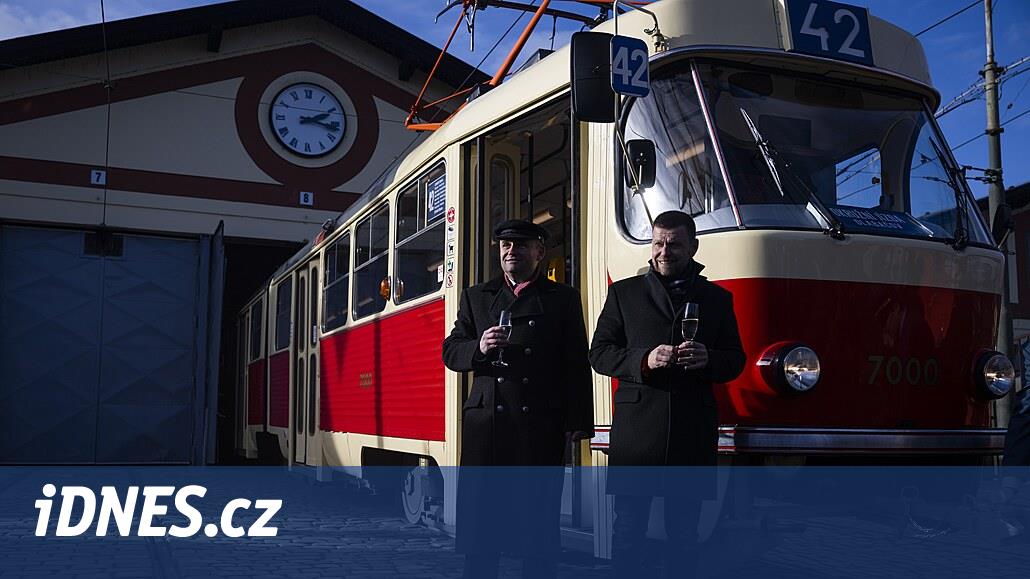Last time today. Prague says goodbye to the T6 square trams. They drove in the streets for a quarter of a century
The T6 trams from the ČKD factory in Prague followed the legendary T3 model from the 1960s, but never saw its fame or expansion. Their angular design was due to the era of origin and at a time when transport companies around the world were introducing low-floor models en masse, into which passengers had to continue to climb several steps. In the end, they still managed to travel in Prague for a quarter of a century, the first passengers were picked up in November 1995, and the transport company will finally say goodbye to them today.
The T6A5 trams will run from 08:00 to 18:00 at 15-minute intervals on line 4 from Smíchov Railway Station to Čech Square. At 18:15 all six trams will leave Smíchov Railway Station on their way through Prague. They will travel along the route Anděl, Újezd, Malostranská and through Chotkovy sady to Špejchar, where people can take pictures. At 19:00 they will set out on their last ride to their home depots. After today, the company will keep two T6A5 trams, which will run on tourist retrolines.
When the Transport Company of the Capital City of Prague (DPP) took over the first of a total of 150 T6A5 cars in the mid-1990s, which meant a significant improvement for passengers. For example, they saw a more modern interior such as upholstered seats (later the seating capacity was expanded by a third when two seats next to each other began to be supplied on the right side of the car) or more powerful ventilation. The method of heating has also changed, instead of heated seats as the T3 had, the vents in the wall of the car near the floor were solved.
Drivers also had to get used to the news, probably the most significant was the change in tram control, instead of the traditional pedals, a lever is used for driving and braking the car, located on the counter to the left of the seat. The electrical equipment of the tram was also more modern, and a large coupler was also visible to laymen; trams can also be connected to each other not only for control, but also for power supply from the trolley. Unlike the T3 type, in the case of a two-car set, it is sufficient if the pantograph has only one car pulled out.
Střešovice depot, T3 trams. Photo: Šjů / Wikimedia commons / CC from SA 3.0
The most visible change was the outer shape, instead of round T3 shapes by František Kardaus came square lines. However, they were no longer a novelty in the mid-1990s either in the ČKD production program or in the streets of Prague. Square trams have been manufactured since the early 1970s, when the Smíchov factory came up with a T5 prototype. As Robert Mara writes in the book Trams of the Unified Type Series T5, Kardaus is also suitable for design, but the economy had to adapt to socialist possibilities.
Prototype of the Tatra T5B6 tram in Litvínov. At the Litvínov stop, stadium. View from SK Neumann street, track behind the house Vrchlického 1092. Photo: Absolut – www.prazsketramvaje.cz / Wikimedia commons / CC by SA 3.0
One of the follow-up to the eventually never produced “five” was the double-sided articulated tram KT8D5, which appeared in the streets of the capital of the then Czechoslovakia as a prototype as early as 1985 (serial pieces were determined between 1986 and 1990). However, the newer T6A5 differed from this model, not least in that it did not have a driver’s cab on either side. For example, the Prague “six” received a different gray-red-white paint and also a different type of door.
Even before Prague, the T6A5 trams appeared in Bratislava (1991) and Košice (1992), the first Czech transport company to take over the type, then the Ostrava one in 1994. The fifth city that bought the “six” as new was Brno. In the end, a large part of the cars discarded by the DPP went to the Moravian metropolis. In the spring of 2019, 30 T6A5s were in operation on the streets of Prague, but then more sales came and, apart from the three tram museums, only the last five operational ones remained.
Unlike the “three” – but also the two-sided articulated “eight” – the Prague T6A5 cars have never been reconstructed, and because of this, their service in the capital has come to an end. DPP was able to allow their disposal thanks to the fact that it has both a stock of reconstructed T3 (over 380 pieces) and a modern high-capacity low-floor type 15T (the company bought 250 of them). It also has almost fifty modernized KT8 and over 50 low-floor 14T.





